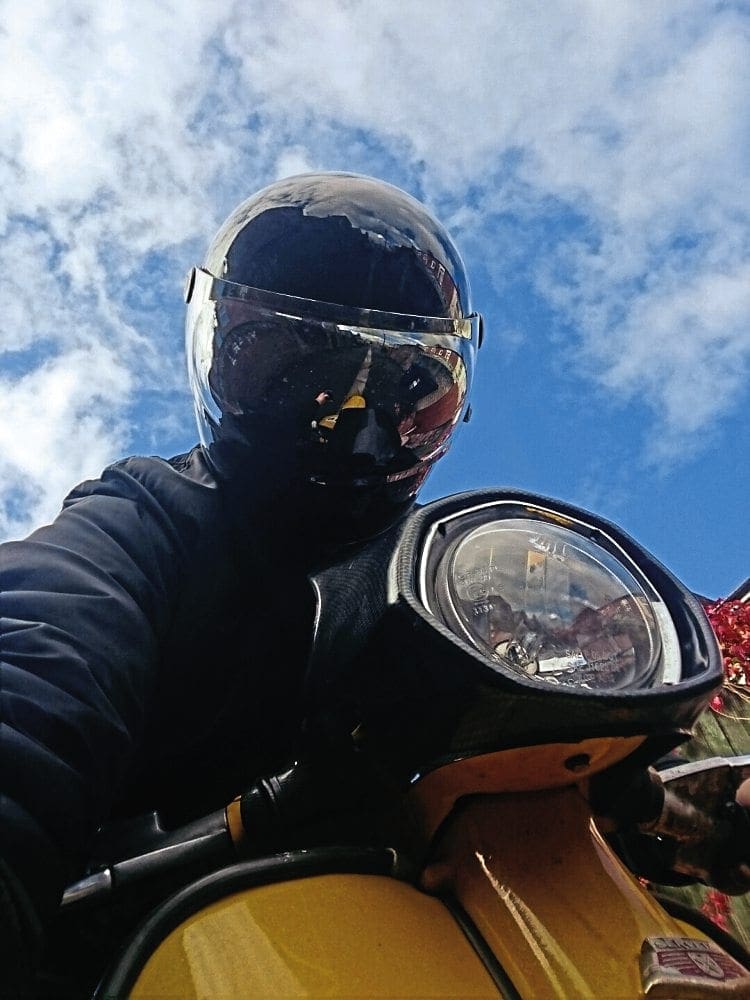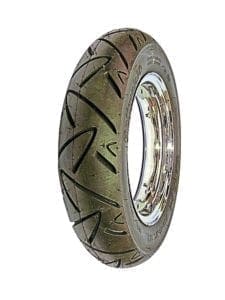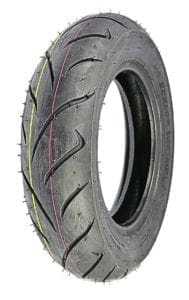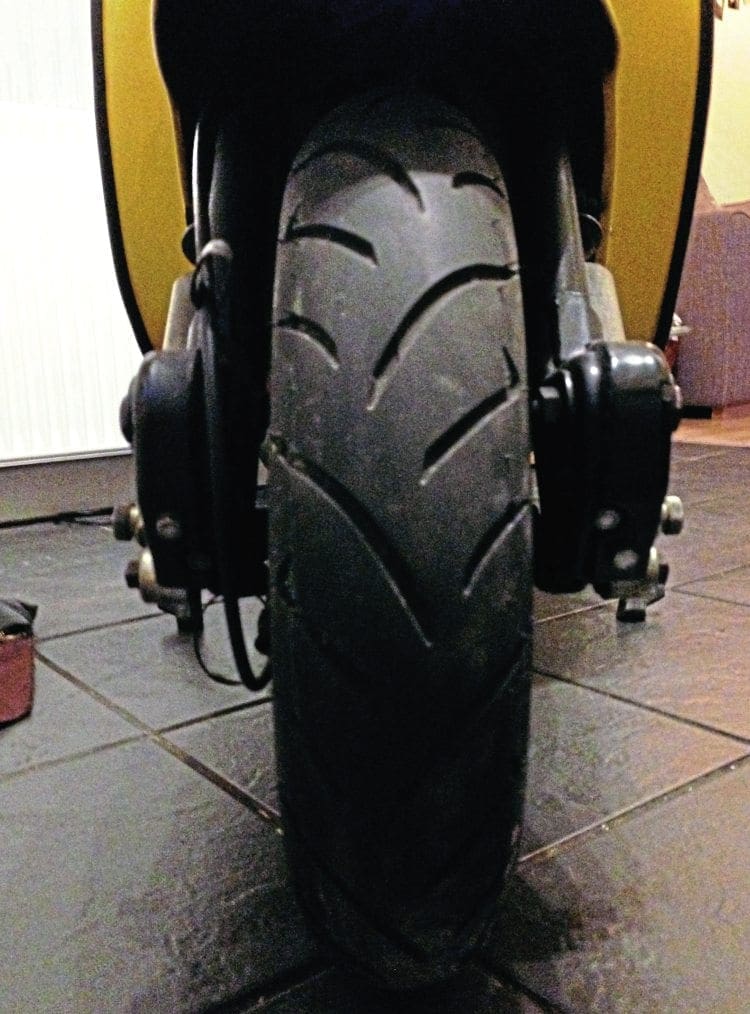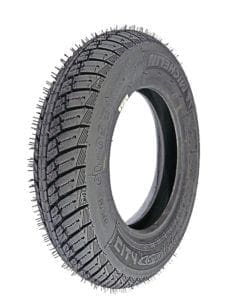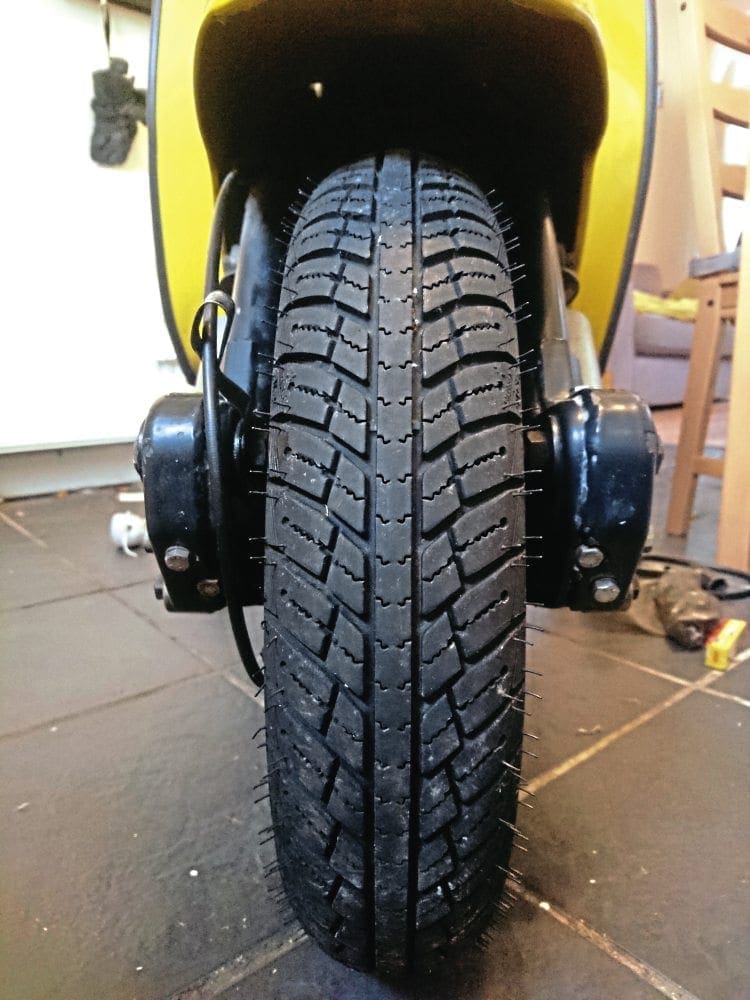Whether covering thousands of miles each year, or pottering to the shops on a Sunday it’s important to choose the right rubber. With safety in the front of our minds, cost should rightly get pushed to the rear, and the only thing which matters is how they perform. Jordan finds out…
Much in the world of scooters is subjective, with some topics being far more subjective than others. Go to a club meet or a rally and you’ll hardly even get a definitive answer for any question. Some topics at least, like exhausts or tuning kits, can have some science applied, but this is much more difficult for the likes of oil (don’t get me started) or in this case tyres and how they perform in comparison to each other. It goes without saying that tyres are a critical component, after all they are what provides the grip which keeps our beloved machines upright. Therefore, I have compiled an informative and balanced comparison of some of the newest tyres on the market.
Having a background in science, I understand how critical it is for a standard set of conditions to be created for any test work. While I couldn’t isolate road and weather conditions, I wanted to keep all other variables to an absolute minimum. So it was to be one test rider, with the same mechanical components throughout the test.
Having one rider means my opinions will be consistent and comparable against each tyre. Similarly, using the same scooter is just as important as there is such a variety of suspension systems out there that all handle so differently, never mind the difference between various makes and models of scooters! With such a variety of tyres out there it’s not practical to test them all, and so I have tried to look at what’s currently popular and in demand.
A ‘load’ of old…ratings?
Phrases such as load ratings and speed ratings are often used in the world of tyres, quite often you’ll find off letters/numbers stamped on your tyre sidewalls. So let’s start deciphering these to figure out what they mean and why they are important.
For scooter tyres there are three main markings of interest:
- Tyre size
- Speed rating
- Load rating
The tyre size is a simple one, for Lambretta and Vespa they are generally 3.50 x 10. The 10 relates to the inside diameter of the tyre (which fits your 10in rims) and the 3.50 relates to the width of the tyre in inches. However, this is somewhat old fashioned, and modern scooters use a slightly different metric system. For example: 100/90-10 which is the closest modern metric equivalent. It is not an exact replacement as it is slightly wider, but has the same ‘height’ and therefore will not affect gearing ratios. The 100 is the width in mm and the 90 relates to the height of the tyre as a percentage of its width. The height of the tyre in this case is 90% of the width (90mm). Finally the 10 is the same as above… the rim size (in inches) which it fits.
Speed ratings and load ratings go hand in hand; they are a code that specifies the maximum speed the tyre can carry the listed load at. Let’s consider speed ratings independently first of all. Historically, many scooter tyres are J rated and, if you look at the following table, you can see how that equates to a speed rating of only 62mph. However, many scooters are easily exceeding those speeds these days so it may be of some comfort to know that many newer and sportier tyres have much higher speed ratings.
The load rating is important due to the simple fact it is the load (weight) that the tyres have been designed to withstand. You will generally see the load rating next to the speed rating and it is denoted via a numerical code. Example: 59J means a load rating of 243kg (code 59) and a speed rating of 62mph (code J). We have noted the load rating for each tyre in the tests below. Recently, newer scooter tyres have been coming onto the market with ever increasing load ratings. This is great news for us, as many rally going scooterists end up carrying a phenomenal amount of luggage!
Another thing to bear in mind when considering load ratings, is that when a vehicle is cornering, centrifugal force means that more of the weight of the vehicle transfers to the side wall on the outside of the tyre. If this weight exceeds the maximum weight loading of the tyre, there is a risk that this will fail, potentially with very serious consequences. It is therefore very important that the weight rating of a tyre is suitable for the scooter and luggage carried. So with the classroom session behind us, let’s have a look at a few of the contenders.
| Rating | F | J | L | M | P | R | S | H | V | Z | W | (W) |
| MPH | 50 | 62 | 75 | 81 | 93 | 106 | 112 | 130 | 150 | 150+ | 167 | 167+ |
| KM/H | 80 | 100 | 120 | 130 | 150 | 170 | 180 | 210 | 240 | 240+ | 270 | 270+ |
CONTITWIST
Speed rating: M (81mph)
Load rating: 59 (243kg)
Rear tyre mileage: 2000 (approx.)
RRP: £31.99
Boasting a decidedly sporty tread pattern, the ContiTwist is a modern looking tyre and one I have personally used over several years. Intriguingly, the front and rear tyres are designed so that, when fitted, the tread patterns are opposing. I can only assume that this has been done to help the rubber more effectively and efficiently disperse road water as and when conditions demand.
Whatever the weather though, I have always found these tyres consistently good in a variety of conditions. The tread profile does lend itself well to precise and effective cornering performance when you’re in a hurry. Thankfully, even in wet and generally slippery conditions they remain reasonably grippy and inspire a certain degree of confidence that you’re not going to come a cropper any time soon. These are a well-balanced option.
K61
Speed rating: P (93mph)
Load rating: 59 (243kg)
Rear tyre mileage: 800-1000 (approx.)
RRP: £39.99
These were a tyre I purchased specifically off the back of rave reviews from others. With incredibly high speed ratings for a scooter tyre at 93mph, they should have been the real deal. However, I was left a little disappointed as I could literally see the tyre wear with every mile I rode.
After riding to only two rallies and some day-to-day trips the tyre was shot! The performance didn’t really compensate for the rate of wear either. In the dry they were more than respectable, but generally not so good in anything less than perfect conditions.
If it was wet then it almost felt as if my frame was bent and the front of my Lambretta was trying to go somewhere different from the rear! So overall I’d say perfect for the Sunday ‘sports’ rider out for a dry-blast, but not recommended for the serious all-weather rally goer.
SCOOT SMART
Speed rating: P (93mph)
Load rating: 51 (195kg)
Rear tyre mileage: 1700 (approx.)
RRP: £28.99
I was pleasantly surprised with the performance of the Dunlops. They seemed to handle well in any condition and withstood all that I could throw at them; my Lambretta really was a pleasure to ride with these tyres fitted. The nice round profile meant cornering was a breeze and very enjoyable.
They didn’t cause much concern in wet conditions either, and handled well in adverse conditions. The only slight negative was that the rear tyre wore a tiny bit faster than I would have liked. Having said that, I’d probably take a hit on that for a tyre that worked so well for me and my scooter in all other areas.
Overall, I’d say these are good tyres which handle well whatever conditions you end up riding through, with average wear patterns (thanks to MB for supplying the tyres).
MC32 (MUD AND SNOW)
 Manufacturer: Mitas (formally Sava) Speed rating: P (93mph)
Manufacturer: Mitas (formally Sava) Speed rating: P (93mph)
Load rating: 51 (195kg)
Rear tyre mileage: 1500 (approx.)
RRP: £45
If you truly want an aggressive looking tyre, then this is for you. I received many a comment from rally going scooterists who were impressed with the chunky, yet sporty, tread pattern. Anyway, designed as a year-round tyre, they did cope well in all weather conditions.
The main test they faced was my ride to Tenby, which turned into a 12 hour epic in torrential rain and sleet. But at no point during this horrendous journey did I once worry about holding onto the roads! The profile is not the roundest though and you could feel that when trying to lean over. Good wear pattern, average handling, outstanding in adverse weather conditions. (Thanks to Sava/Mitas for supplying the tyres)
CITY GRIP (MUD AND SNOW)
Speed rating: P (62mph)
Load rating: 59 (243kg)
Rear tyre mileage: 2500-3000 (approx.)
RRP: £31.50
These were probably the real surprise of all the tyres I tried. Philipp at Scooter Centre Köln, said I should try them, though they were not something I would normally consider. They had a low speed rating, a very classic-looking tread pattern and the branding made me feel they were more suited to commuters.
In fact, the tyre had a surprisingly goad profile and they really did hold the road fantastically well. I undertook two high mileage tours with these fitted, one to the Isle of Mull and the other around Europe to Venlo. They handled any conditions I encountered. Normally for a tyre with such good performance you’d expect the wear rate to be high, but this wasn’t the case. After almost 3000 hard miles, they still had a little life left in them! Grip, handling and wear rate were excellent. (Thanks to Michelin for supplying these)
PERFORMER
Speed rating: L (75mph)
Load rating: 59 (243kg)
Rear tyre mileage: 1800 (approx.)
RRP: £23.50
I thought I’d give these a bash as, after all, they are SIP’s own branded tyre and I rate SIP highly. The most attractive thing about these tyres is the price; in comparison to the others tried here they are unbelievable value. The profile seemed worryingly boxy at first but have no fear — this soon disappears once the tyre is fully inflated. My opinion is that they are ideal for high-mile riders who want low cost and reasonable longevity without sacrificing much in performance (although I’d take extra care in the wet).
Personally, I’d be more inclined to use them on high mileage tours where having an expensive rear tyre that wears out in less than 1500 miles is impractical. These are now also available in size 3.00 x 10 and therefore suitable for small frame Vespas too. These really are a welcome addition in a limited market. (Thanks to SIP for supplying the tyres)
Words & photographs: Jordan
Thanks to MB Scooter Tyre Store and SIP for help with additional stock images.

